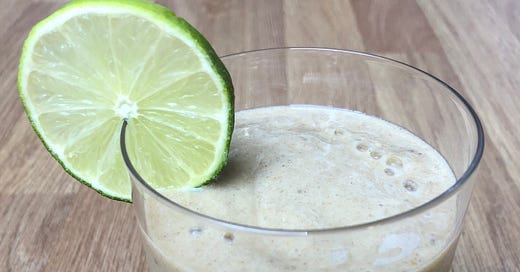Buzzing: an Africa special
Howdy everyone, I hope you’re keeping well. We’re travelling to Africa this week: I first came across insect farming in Africa, so it seems apt to dedicate an issue of the newsletter to this amazing continent.
This week in Buzzing:
Africa’s insect protein sector is buzzing
Q&A: Chrystantus Tanga, ICIPE
Test Corner: I nail the cricket smoothie
What business does Buzzing have to do on a continent where people already eat insects, I hear you ask? Well, quite a lot actually.
I should start by stating the obvious: Africa is a continent made up of 54 countries and insect consumption varies enormously from one area to the next. Also, just because there are a lot of edible insects doesn’t mean everyone eats them. In fast-growing economies like Kenya, young people are increasingly shunning traditional fares in favour of western-type foods. Researchers at the International Center for Insect Physiology and Ecology (ICIPE) in Kenya have therefore tried to develop ‘modern’ insect foods such as biscuits, crackers or a powder you could add to porridge or yoghurt.
They are also trying to bring insect production in line with modern food standards. Most insects in Africa are foraged in the wild and then sold on street markets in fairly unhygienic conditions: being able to farm insects would not only be more sustainable and safer, it would also turn insects into a readily available source of protein.
In Madagascar, the Sakondry project, which I wrote about back in September, is looking at ways to semi-rear insects in the wild by planting the Sakondry’s host plant: it’s a brilliant system for remote communities struggling with food security because it doesn’t require big investments: just plants and a little gardening to increase your bounty of protein. The best thing is that the format may be replicable in many other areas of Africa and Asia.
Also in Madagascar, Valala Farms is developing more “conventional” insect farming. They are building a large-scale facility in the capital Antananarivo, and they’re keen to establish what other insect species they could farm in different areas of Madagascar (native species are always best) and what organic waste source they could use for the insects’ substrate.
Over in West Africa, Dr Tilly Collins from Imperial College London is looking at rearing palm weevils out of discarded palm trunks as part of a greater drive to make the palm oil sector more sustainable.
Over on the feed side, the Insect Technology Group, which was founded in South Africa back in 2009, was one of the first companies in the world to commercially rear Black Soldier Fly (BSF). They have become one of the leaders in the field, now expanding in the US and Europe, and pioneered the development of BSF-based animal feed. They have also trialled the use of unconventional substrates such as abattoir waste, animal manure and human excrement. Back in Kenya, new players such as InsectIPro and Gaea Foods have made a name for themselves in the BSF market and becoming increasingly sophisticated.
I also mentioned frass in the last edition. I could go on and on. My point is that far from being a static, traditional sector, the insect industry in Africa is building up on its heritage, innovating and helping shape the sector globally.
The Q&A: Dr Chrysantus Tanga, Insects for Food, Feed and Other Uses Programme, ICIPE
Dr Chrysantus Tanga grew up in Limbe, in southwestern Cameroon. As a boy, his parents gave him edible insects as treats, which he would then share with friends. Edible insects are part of his culture, he says. He trained as an agricultural entomologist and initially specialised in integrated pest management. But when the opportunity came up in 2014 to pioneer a new research programme about insects as food and feed at the International Centre for Insect Physiology and Ecology (ICIPE, based in Kenya), he jumped on it. I met him back in February 2020, when he gave me a fascinating tour of ICIPE’s research facility (the piece starts at 17 min). We caught up for Buzzing over Zoom.
Many people in Africa already eat insects regularly so why is African research on insect protein so important?
People in Africa have long eaten insects, but they don’t know the nutritional benefits they get from insects. Yet it’s extremely important: for instance, insect-based feed for laying hens or broiler chickens can suppress pathogens in the gut, which means we could reduce the use of antibiotics in poultry production. This is a huge deal.
Also, by developing the science, we are able to give back to the community, to encourage entrepreneurs to start their own insect-based enterprises or farmers to change their practices of depending on fishmeal or soya bean.
What are the most exciting research areas you’re currently working on?
We have developed good protocols for extracting oil and we have analysed this for over 10 different insect species. Insect oils contain high levels of Omega-3 and Omega-6 fatty acids, which are lacking in most plant-based sources; they are also very rich in vitamins A and E.
We have also successfully extracted chitin and chitosan from the skin of the pupae of the Black Soldier Fly (BSF). Once the fly emerges, it leaves a hard skin shell, which is a waste product for BSF farms. We are now converting this waste into chitosan, which is a high value-added product. Chitosan has multiple uses: you can use it as a soil amendment to suppress plant parasitic nematodes; as a probiotic to boost gut health in animals and humans; in medicine to develop capsules/supplements, accelerate wound healing or prevent tooth decay; or as a food preservative for agricultural products. Insect chitosan will be much more sustainable to produce than existing commercial chitosan, which comes from crab and shellfish. We are now testing product applications.
Is the West’s growing interest in insect protein an opportunity or a threat for Africa?
The West’s interest isn’t a threat at all. I would say quite the opposite! Africa hosts over 30% of insect species consumed globally. We have a huge diversity, and all the insects that the West is looking at exist here – crickets, grasshoppers, BSF etc. Africa has the advantage: Europe is investing a lot to produce insects, but we don’t need that here: the weather is very good, the conditions are just right for insect production. It’s going to open a lot of opportunities – we already see it happening.
Test corner: Mango cricket smoothie
For my Africa special, I decided I would celebrate one of out favourite tropical fruit at home, and a staple of so many of my trips on the continent: mango.
I’ve had my eye on insect smoothies for a while: every insect product website seems to have a version of it, and they sound yummy. My concern has always been that I wouldn’t be able to blend the insects finely enough and would end up with a grainy texture - definitely not what you’re after in a smooth-ie…
So when I saw a tweet by Instar Farming explaining that their ultra-fine cricket powder was particularly suited to drinks application, I thought this was my ticket to the perfect smoothie.
My recipe was pretty simple: three small frozen bananas (I freeze over-ripe bananas when I can’t be bothered to make another round of banana bread/muffins), one whole mango, a generous glug of milk, one tablespoon of cricket powder, 30 seconds in the food processor, and a squeeze of lime to finish. Voilà.
It was absolutely delicious: creamy, wholesome, with a little zing. I must say that the cricket flavour was totally k-powed by the banana, mango and lime, but I suppose its point here is nutrition rather than flavour. My daughter sighed delectably with her eyes closed when she tried it and announced that it was “the best thing she’d ever tasted”. High praise indeed.
Hi, I’m Emilie Filou, a freelance journalist. I specialise in business and sustainability issues and have a long-standing interest in Africa. If you liked Buzzing, please share with friends and colleagues, or buy me a coffee. The artwork in Buzzing was designed by Sheila Lukeni.








